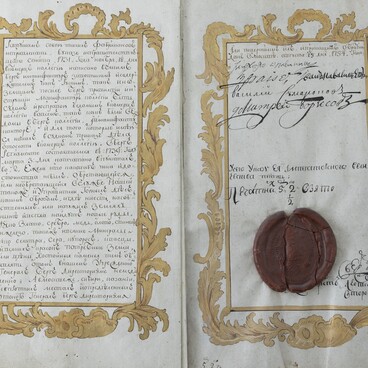In 1815, at the Zlatoust Ironworks, the “Factory for the production of white weapons, various steel and iron products” was opened, which later became known as the Zlatoust Arms Factory. The first products were officer’s swords, soldier’s infantry swords, cuirassier broadswords and hussar sabers. Along with combat weapons, decorated weapons were made at the factory.
Thanks to the talent of the masters Ivan Nikolayevich Bushuyev and Ivan Petrovich Boyarshinov, the craft of engraving and gilding blades gave rise to an applied art, which later became known as Zlatoust steel engraving.
In 1827, the heir to the throne, the future Emperor Alexander II, turned nine years old. The administration of the Zlatoust Arms Factory decided to give him an unusual gift — a “Technical Cabinet”. It consisted of a set of special tools used in weapons production, made to a reduced scale.
The set also included a number of smaller copies of all types of blade weapons that were manufactured at the time, and at different stages of production — from a “forged” blank to finished sabers, small swords and broadswords. A few miniature blades were decorated with etching, bluing and gilding.
Along with other items, the set comprised a large album with drawings and sketches. It also included specimens of ores and fluxes, metal at various stages of processing — from cast iron to iron and steel, and equipment models. The unique collection consisted of 504 items and was essentially a kind of textbook, which made it possible to visually study the mining, metallurgical and weapons production.
All the items were placed in a special cabinet with many drawers. When sent to Saint Petersburg, the gift was accompanied by an engineer, as well as its key creators. On October 24, 1827, the “Technical Cabinet” was presented to Emperor Nicholas I and the heir to the throne. The gift was appreciated: a letter came from the capital notifying that everyone who had been involved in making the gift would be awarded.
Later, the “Technical Cabinet” was handed over to the Mining Institute (now Saint Petersburg Mining University), and in 1960, 34 items were transferred from the Plekhanov Leningrad Mining Institute (as the Mining Institute became to be known after 1917) to the Zlatoust City Museum of Local Lore.
Thanks to the talent of the masters Ivan Nikolayevich Bushuyev and Ivan Petrovich Boyarshinov, the craft of engraving and gilding blades gave rise to an applied art, which later became known as Zlatoust steel engraving.
In 1827, the heir to the throne, the future Emperor Alexander II, turned nine years old. The administration of the Zlatoust Arms Factory decided to give him an unusual gift — a “Technical Cabinet”. It consisted of a set of special tools used in weapons production, made to a reduced scale.
The set also included a number of smaller copies of all types of blade weapons that were manufactured at the time, and at different stages of production — from a “forged” blank to finished sabers, small swords and broadswords. A few miniature blades were decorated with etching, bluing and gilding.
Along with other items, the set comprised a large album with drawings and sketches. It also included specimens of ores and fluxes, metal at various stages of processing — from cast iron to iron and steel, and equipment models. The unique collection consisted of 504 items and was essentially a kind of textbook, which made it possible to visually study the mining, metallurgical and weapons production.
All the items were placed in a special cabinet with many drawers. When sent to Saint Petersburg, the gift was accompanied by an engineer, as well as its key creators. On October 24, 1827, the “Technical Cabinet” was presented to Emperor Nicholas I and the heir to the throne. The gift was appreciated: a letter came from the capital notifying that everyone who had been involved in making the gift would be awarded.
Later, the “Technical Cabinet” was handed over to the Mining Institute (now Saint Petersburg Mining University), and in 1960, 34 items were transferred from the Plekhanov Leningrad Mining Institute (as the Mining Institute became to be known after 1917) to the Zlatoust City Museum of Local Lore.







